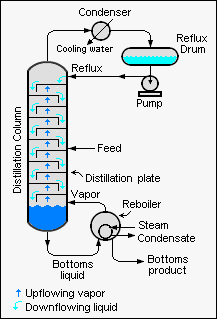CZ:Featured article/Current: Difference between revisions
imported>Chunbum Park (→Potassium in nutrition and human health: Pompeii) |
imported>Chunbum Park (→Pompeii: Fenske equation) |
||
| Line 1: | Line 1: | ||
== '''[[ | == '''[[Fenske equation]]''' == | ||
---- | ---- | ||
{{Image| | {{Image|Total Reflux.png|right|275px|Industrial distillation column operating at total reflux}} | ||
''' | The '''Fenske equation''' is used for calculating the minimum number of [[theoretical plate]]s required for the separation of a binary feed stream by a [[Continuous distillation|distillation column]] that is being operated at total [[Reflux (distillation)|reflux]] (i.e., which means that no overhead product is being withdrawn from the column). The derivation of the Fenske equation assumes that the [[relative volatility]] is constant in the distillation column. | ||
Theoretical plates are also often referred to as [[theoretical tray]]s or [[equilibrium stage]]s. | |||
The | The equation was derived in 1932 by Merrell Fenske, a professor who served as the head of the [[chemical engineering]] department at the Pennsylvania State University from 1959 to 1969.<ref>{{cite journal| author=M.R. Fenske|title=Fractionation of Straight-run Pennsylvania Gasoline|journal=Industrial Engineering Chemistry|volume=24|issue=5| pages=482-485|date=May 24, 1932}}</ref> | ||
''[[ | When designing large-scale, continuous industrial distillation towers, it is very useful to first calculate the minimum number of theoretical plates required to obtain the desired overhead product composition. | ||
''[[Fenske equation|.... (read more)]]'' | |||
{| class="wikitable collapsible collapsed" style="width: 90%; float: center; margin: 0.5em 1em 0.8em 0px;" | {| class="wikitable collapsible collapsed" style="width: 90%; float: center; margin: 0.5em 1em 0.8em 0px;" | ||
|- | |- | ||
! style="text-align: center;" | [[ | ! style="text-align: center;" | [[Fenske equation#References|notes]] | ||
|- | |- | ||
| | | | ||
{{reflist|2}} | {{reflist|2}} | ||
|} | |} | ||
Revision as of 02:46, 28 October 2012
Fenske equation
The Fenske equation is used for calculating the minimum number of theoretical plates required for the separation of a binary feed stream by a distillation column that is being operated at total reflux (i.e., which means that no overhead product is being withdrawn from the column). The derivation of the Fenske equation assumes that the relative volatility is constant in the distillation column.
Theoretical plates are also often referred to as theoretical trays or equilibrium stages.
The equation was derived in 1932 by Merrell Fenske, a professor who served as the head of the chemical engineering department at the Pennsylvania State University from 1959 to 1969.[1]
When designing large-scale, continuous industrial distillation towers, it is very useful to first calculate the minimum number of theoretical plates required to obtain the desired overhead product composition.
| notes |
|---|
|
